|
|
JAMES BOND
|
|
|
JAMES BOND
|
|
|||||
|
|||||
|
|||||
|
|||||
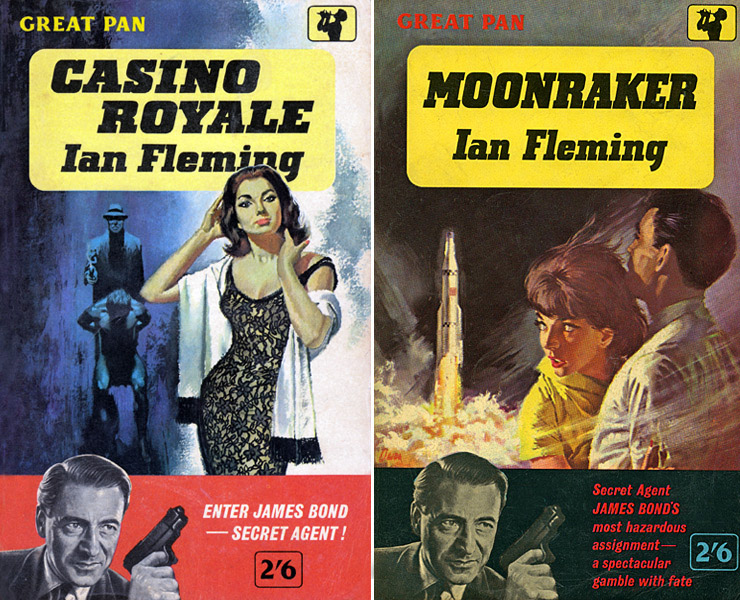 |
|||||
|
DIAMONDS ARE FOREVER quickly sold out its initial 40,000 print-run; and a further printing of 30,000 followed in May, and another 30,000 in September also proving popular. By the end of 1961 DIAMONDS ARE FOREVER had sold 92,000 copies. The new cover clearly transformed sales and twice as many copies were sold than in the previous year. PAN then chose to re-issue CASINO ROYALE, and a new cover was painted to replace the Sam Peffer edition which had sold out in April 1960. Although no artist is credited on this cover it is undoubtedly the work of Pat Owen, as it matched the style of the other titles in the series published at this time. It is only when these covers are seen in context and in the order of their original publication that the true picture emerges. As the Pat Owen covers were reprinted several times over the next two years many have been credited to Sam Peffer, when in reality he only ever provided four James Bond paperback covers for PAN, all of which were signed. Owen by contrast painted the seven published in 1961 (four of which were signed) and reprinted many times. His covers appeared on around 2.1-million paperbacks, whereas Peffer's amounted to just a quarter of that number. Because Sam Peffer was the ‘name’ artist and usually signed his work, Owen's name has been somewhat sidelined in the history books because his signature was obscured on later reprints. A simple Google search of either name will include many Owen works attributed to Sam Peffer, simply because his name is not visible on the cover. Some websites and so-called ‘expert’ commentators even attribute Owen's work to Peffer when an earlier edition that actually showed his signature is displayed! These errors have perpetuated for decades, and it is only when the actual printing history is seen in the correct chronological order that the truth reveals itself. |
|||||
 |
|||||
|
A new edition of MOONRAKER was published in May 1961, with a Pat Owen cover with his signature clearly visible on the artwork. Owen's version is similar to Sam Peffer's, in that it shows James Bond and Gala Brand watching the Moonraker rocket launch, but Bond's face is now beginning to be less prominent. Although Owen's style is different to Peffer's it appears he has actually based the faces on real people, very likely using a young Joan Collins and Christopher Lee as the photo reference. Owen does not appear to have based his other illustrations on real people and the unusual positioning of the figures on the MOONRAKER cover would have been hard to achieve from memory alone. Later editions with the deeper yellow band obscured Owen's signature on the artwork reused from the 1961 editions. Sales of MOONRAKER in 1961 totalled 87,000 copies which were made up by the last remaining stock of the Sam Peffer cover which had been reprinted in January, and the two printings of the new Pat Owen edition, amounting to just 50,000 copies in May and September. |
|||||
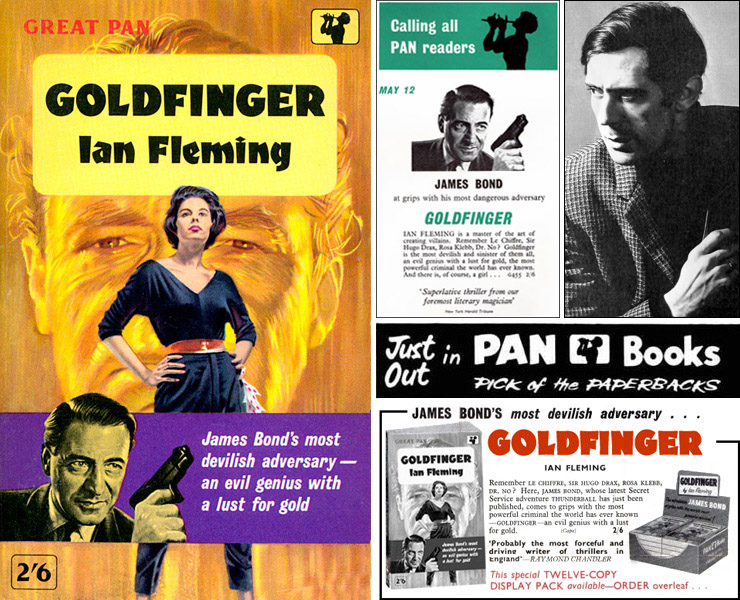 |
|||||
|
On May 12, 1961, Ian Fleming's seventh James Bond novel GOLDFINGER was published for the first time in paperback by PAN Books, with a cover by Pat Owen [pictured above top right], and featuring a painting of Tilly Masterton in front of a huge golden head of the eponymous villain. The initial print run of 100,000 copies of GOLDFINGER sold out following its publication, and a further 50,000 were quickly printed. The second edition also sold out within a month, and a third printing of 30,000 copies were issued in June 1961. By the end of 1961 GOLDFINGER had sold 161,000 copies of the PAN paperback, making it their biggest-selling Ian Fleming title that year, and also the largest number of sales of an individual title ever sold in one year. Although GOLDFINGER was now part of the first uniform series of covers, PAN still had to standardise the typeface used for the title of each book. GOLDFINGER saw a return to the ‘Fanfare’ font first used on DIAMONDS ARE FOREVER earlier in the year. |
|||||
|
The first six James Bond novels had each sold an average of 85,000 copies in paperback throughout 1961, which was over twice the number in the previous year. CASINO ROYALE was still the biggest-selling title with overall sales of almost 250,000 copies during the seven years since its paperback debut. Surprisingly MOONRAKER was not far behind despite being out-of-print throughout 1958, with the other four titles selling in similar numbers. However all that was about to change with the announcement that the James Bond novels were about to be turned into a film series. 1.3-million copies of the PAN James Bond paperbacks would be sold in 1962 alone, which almost equalled the total number of sales for all seven titles available in the UK since the release of CASINO ROYALE in 1955. |
|||||
|
|||||
|
Hot on the heels of GOLDFINGER which made its paperback debut in May, came a new edition of FROM RUSSIA, WITH LOVE in September 1961. Rather than replicate the Sam Peffer cover which sold out its 5th printing a few months earlier, Pat Owen chose to paint a new rendition of Tatiana Romanova and dispensed with the figure of James Bond altogether (although he was still represented by Ralph Vernon-Hunt in the green overlay). Owen's signature is again clearly seen on the cover but was covered up on later printings by a new yellow panel. FROM RUSSIA, WITH LOVE was only issued once as part of this series in September 1961 with a print-run of 60,000, making the 6th edition one of the rarer paperback titles. LIVE AND LET DIE was then issued in October 1961, and again with only one printing of 60,000 copies. Pat Owen's artwork is basically a reworking of the original Rex Archer cover from 1957, but with Bond's face now even less prominent. The Rex Archer cover had been in circulation for four years before the five printings totalling 185,000 copies had sold out, and was the least popular of Ian Fleming's novels in paperback so far. The new Pat Owen cover boosted sales with LIVE AND LET DIE selling 82,000 copies in 1961, but it would be another 12 years until the film version turned Ian Fleming's second novel into the third highest-selling title of all the James Bond paperbacks published by PAN Books. |
|||||
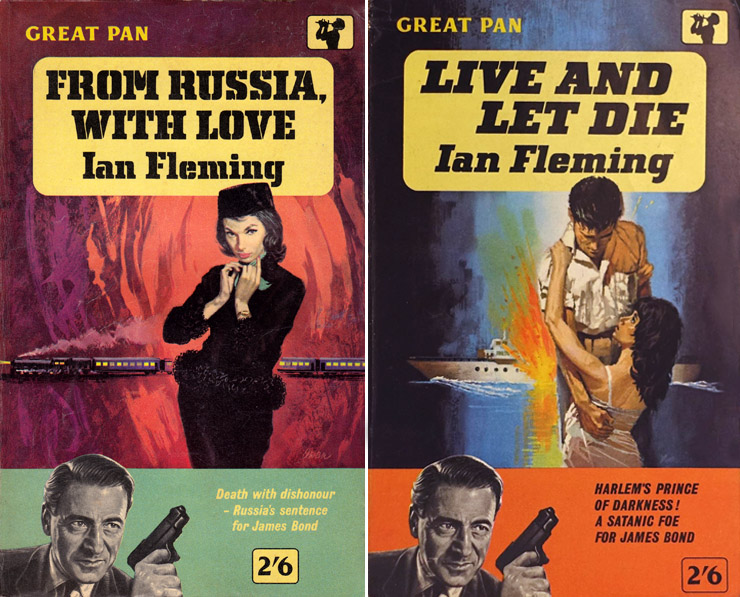 |
|||||
|
Also issued in October 1961 was a new edition of DR. NO with a cover painted by Pat Owen, but this time basically a direct copy of the 1960 Sam Peffer first edition which is why it is sometimes credited to him. Looking at the two covers side-by-side one can clearly see it is not the same artist. James Bond makes a return appearance on the cover in a rather crudely drawn version compared to Sam Peffer's rendition. Pat Owen's cover is rather more sinister than the garish Sam Peffer cover, and marked the last time the face of James Bond would appear on a UK paperback (other than that of the actor playing Bond on the film tie-in editions) until 2006 when a small stylized version was shown on OCTOPUSSY AND THE LIVING DAYLIGHTS ‘Bond Re-jacketed’ edition from Penguin Books. The face of James Bond had appeared on some Progressive Reader Editions from the 1970s and 1980s, but these were not widely available to a mainstream audience. Although it was not unusual for the same artwork to be re-used on different paperbacks throughout the world, it was not common for the same artist to provide different versions for the same book. This did happen with the two paperback editions of Ian Fleming's first non-fiction book The Diamond Smugglers, which was issued as a PAN paperback in 1960 and again in 1963, both times with artwork by David Tayler (1921-1985). |
|||||
|
|||||
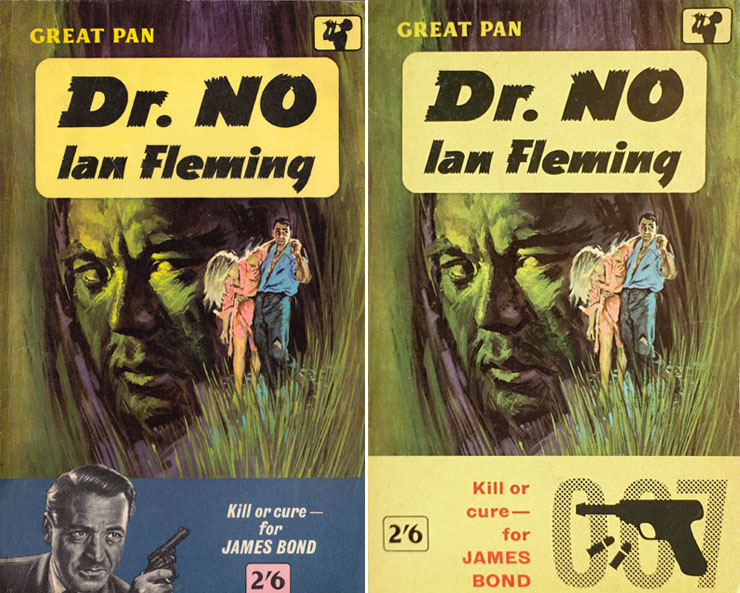 |
|||||
|
PAN Books re-issued the rest of the series in March/April 1962 retaining the Pat Owen covers. As the artwork already existed it was just a matter of laying the new yellow panel over the top of the Ralph Vernon-Hunt image. This was done incorrectly on the 7th edition of DIAMONDS ARE FOREVER resulting in the top of Hunt's head still visible to the right of artist Pat Owen's signature. This error remained on all editions until the 12th printing in August 1963. There were only 640,000 paperback editions of those novels with the Ralph Vernon-Hunt overlay printed, and four of those had Owen's signature clearly visible. The loss of Pat Owen's signature on the rest of the covers in this series is regrettable, as the yellow-band editions were printed in far greater quantities than the 1961 paperbacks. Pat Owen and Sam Peffer had started lobbying for higher payments for their work but publishers resisted and began using cheaper foreign artists, or simply purchasing photographs for use on their covers. One of the Italian artists who relocated to the UK in 1958 was Renato Fratini (1932-1973); who painted many paperback covers, and also the superb artwork for the From Russia With Love (1963) UK Quad-crown poster and several Carry On films during his prolific career. |
|||||
|
|||||
|
DR. NO was issued once again in April 1962 but this time as a film tie-in edition featuring Sean Connery, Ursula Andress and Jack Lord on the cover. Doctor No himself (Joseph Wiseman) was relegated to a still on the back cover. This edition was issued six months before the release of Dr. No in the UK and existed alongside the Pat Owen covers as Great PAN G335, and again when the series was re-issued with a new catalogue number in January 1963. May 11, 1962, saw the paperback debut of Ian Fleming's 1960 short story anthology FOR YOUR EYES ONLY. The cover artist this time was Benjamin Ostrick (1916-1966) who often painted under the pseudonym J. Oval. Ostrick was another freelance artist working in London who predominantly provided artwork for women's magazines and the more romance oriented paperback covers. His FOR YOUR EYES ONLY illustration features none of the masculine action seen on earlier titles, so perhaps this is why he was chosen to provide what would become the last painted paperback cover from PAN Books. The woman Ostrick depicted is presumably Lisl Baum from the short story RISICO, who apart from the blonde hair bears little resemblance to Ian Fleming's description. Aside from the inclusion of the words ‘JAMES BOND SECRET AGENT’ and the 007 logo on the cover, there is little to identify this as a James Bond paperback, and Ostrick's artwork is very much in the style of his other works. FOR YOUR EYES ONLY was the second most popular title behind DR. NO in 1962, selling almost a quarter-of-a-million copies by the end of the year. |
|||||
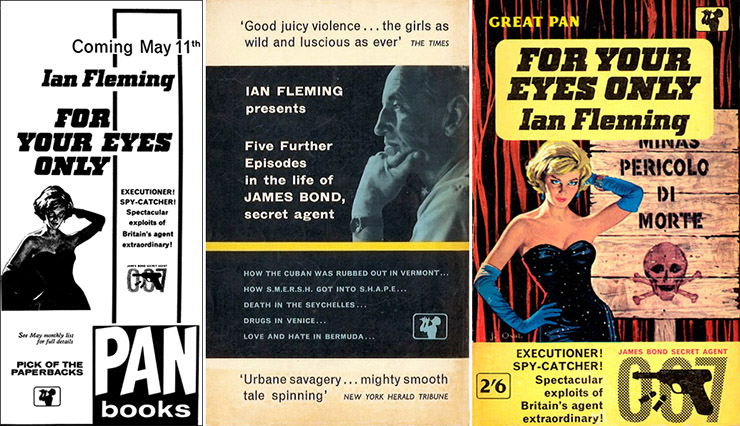 |
|||||
|
Interest in the novels grew with the release of the first James Bond film in October 1962, and sales of PAN James Bond paperbacks consequently doubled from the previous year. The total number sold in 1962 topped the million mark for the first time - with sales of DR. NO alone reaching 432,000, becoming the biggest-selling title so far. In 1963 the series was re-priced and re-issued again, this time the titles had been given a new PAN catalogue number. The seven existing James Bond novels in paperback were issued again at the new 3/6 price point with catalogue numbers X232-X239. The numbering now corresponded to the original publication order of Ian Fleming's novels, although the titles were still issued out of sequence in early 1963 when stocks of the earlier editions ran out. This series dropped the GREAT PAN strap-line but retained the Pat Owen/J. Oval artwork and featured the new PAN logo with the catalogue number of the book in the top right corner. DR. NO (X237) was also re-priced and re-issued with the film tie-in cover in January 1963. |
|||||
|
|||||
|
|||||